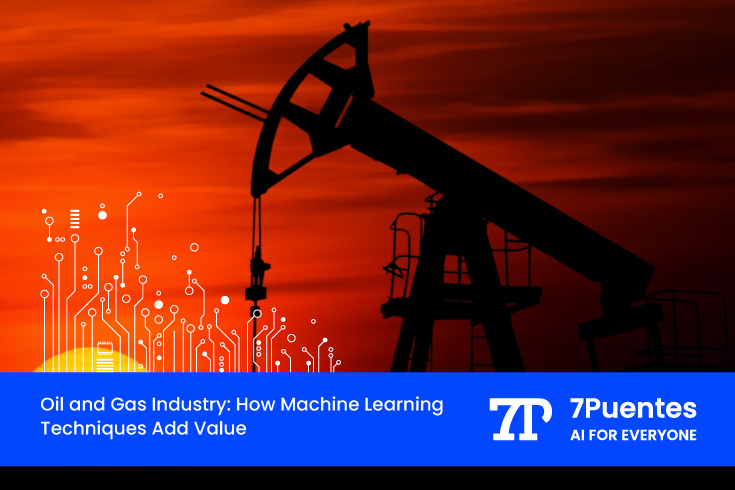The oil and gas industry has always been at the forefront of technological advancements, constantly seeking ways to optimize operations and increase profitability. In recent years, one innovation that has garnered significant attention is machine learning (ML). This groundbreaking technique involves using algorithms and statistical models to analyze large amounts of data in order to make predictions and decisions without explicit programming. With the exponential growth of data in the industry, applying machine learning in oil and gas has become essential for companies looking to gain a competitive advantage. From operational efficiency to revenue optimization, it’s time for oil and gas executives to pay close attention to this game-changing technology.
Introduction to AI in Oil and Gas
Fintech, digital media, healthcare, and e-commerce: many industries have already successfully incorporated data science into their operations, improving their products and services and reaching new market segments. What about the oil and gas industry? It hasn’t reached that level of maturity yet.
There are many «pick and shovel» industries today that are trying to automate their processes to recover lost time: mining, electromechanical, drilling, and energy are some of them.
These industries are choosing to update their production schemes so that automation is part of their processes.
For example, the oil and gas industry is beginning to automate preventive maintenance: using sensors to collect data, they are trying to develop models that will allow them to predict when a machine might fail.
The processes and decisions involved in the exploration, development, and production of oil and gas generate enormous amounts of data, which are multiplying exponentially.
Although Big Data & Analytics technologies can provide approaches and tools that are becoming essential for the competitive development of the oil and gas industry, they have not yet reached the necessary maturity to address the processing of their data.
Data, often from disparate sources, is disorganized or in need of a normalization criterion.
However, the growing demand for energy, oil and gas puts pressure on this industry to improve its business and production processes. In this sense, the adoption of an analytical dynamic, along with a strategic rethinking of the objectives to be achieved with this information, are essential elements for these companies to capitalize on their data assets.
Improvement process affecting a «pick and shovel» industry
Drilling is continuous. Thousands of wells are drilled year after year, which facilitates learning from past experience and allows for rapid evolution. In recent years, production has increased significantly through the use of more advanced drilling techniques.
However, progress has been achieved through trial and error, i.e. experimenting with a new technique and sticking with it if it works.
Data analytics offers the opportunity to make experimentation more scientific, so that the introduction of innovations can be evaluated in terms of productivity.
The oil industry generates large amounts of data, both structured – such as temperature and pressure measurements – and unstructured – such as video recordings.
The amount of data is constantly increasing, it comes from different sources and is usually in different formats.
As a result, discovery processes in this area require an important initial step of structuring the data for subsequent organization and management.
Recent advances in machine learning techniques and natural language processing (NLP) for data search applications have made it possible to extract structured free-text information, such as that found in well or reservoir reports and logs. However, the biggest challenge in applying these techniques to unstructured data is understanding industry-specific terms and business jargon to help train AI models.
Artificial intelligence and the stages of the oil and gas industry
As we know, the oil and gas industry is divided into three major sectors: upstream, midstream, and downstream.
Upstream, or the first stage, involves finding potential deposits and drilling and exploiting wells to bring oil or natural gas to the surface.
Midstream involves the transportation and marketing of the raw products.
Finally, the tasks of refining oil and processing and purifying natural gas correspond to the downstream stage.
It is in the upstream stage that artificial intelligence could be applied, feeding AI systems with data collected over the years and presented in different formats, be it structured documents, PDF or handwritten notes, audio or even video files.
What data can be pre-processed in the upstream?
The range of data that can be analyzed is broad, given the variety of sources that can be consulted.
Some useful upstream logs could be
- Seismic studies
- Well logs
- Differentiation of facilities according to their characteristics (depth, storage, power)
- Fuel consumption sheets
- Well activity planning curves
- Daily maneuvering sheets
- Fluid analysis
- Static pressure and flow measurements
- Transient pressure tests
- Periodic well production tests
- Records of monthly volumes of produced fluids (oil, gas, and water)
- Records of monthly volumes of injected fluids (water, gas, CO2, steam, chemicals), and many others.
Ideal operating conditions for each well under various operating conditions could also be added.
What could be gained from processing this data?
It is always important to be clear about the objective when analyzing and relating the information collected.
The data scientist is a specialist in extracting relevant information from the data and interpreting the results, but he or she needs to work together with experts to be able to formulate the right questions and how to get the answers.
This interdisciplinary work opens up a number of opportunities for improvement:
- Reducing operating costs by analyzing seismic data of the surface to be drilled.
- Minimize equipment downtime by evaluating equipment operating conditions along with weather conditions.
- Improve operational safety by reducing the risks associated with the activity and preventing accidents that could affect employees, the environment and company assets.
- Predict the daily fuel consumption of equipment.
IoT in Oil & Gas: Leading the Way in Data Collection
The Internet of Things (IoT) is the technology that enables devices, machines, and other equipment to communicate with each other.
It enables oil and gas companies to manage and store data, build applications, and establish security protocols using data science methods.
Some of its uses and applications include:
- Sensor-based tank monitoring. Sensors monitor equipment performance in real time and store it in the cloud. They send alerts about potential problems and facilitate early decision making by displaying graphs on their digital panels.
- Acoustic monitoring. Sensors continuously measure oil composition and volumetric flow to reduce the use of expensive machinery.
- Seismic sensors. These enable mapping of subsurface drilling sites to identify new drilling locations and optimize production from operating sites.
- Digital replicas of physical assets simplify change analysis.
At 7Puentes, we have extensive experience in this type of 4.0 industries.
We have participated in successful projects where, side by side with experts, we have been able to understand, process and harmonize data with our engineers, as well as develop, analyze and validate hypotheses with our data scientists.
We have the ideal team to take your goals and turn them into value for your processes and products.
Take a step towards automating your business, get great results and watch it grow. We are 7Puentes, we are your next step in innovation. Get in touch with us.


